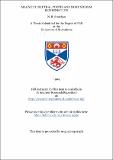Files in this item
Magnetic neutral points and nonuniform reconnection
Item metadata
| dc.contributor.advisor | Priest, E. R. (Eric Ronald) | |
| dc.contributor.author | Strachan, N. R. | |
| dc.coverage.spatial | 84 p. | en_US |
| dc.date.accessioned | 2018-06-19T11:42:18Z | |
| dc.date.available | 2018-06-19T11:42:18Z | |
| dc.date.issued | 1994 | |
| dc.identifier.uri | https://hdl.handle.net/10023/14250 | |
| dc.description.abstract | Ever since the first recorded observation of a solar flare in September 1859, it has been a key question - for physics as a whole and for astrophsics in particular - to ask what mechanism lies behind the sudden, violent release of energy from the sun. It has become increasingly apparent that the complex structure of the solar magnetic field lies at the heart of the answer. The process of magnetic reconnection has, over the years, become the accepted explanation by which magnetic energy can be released on both large and small scales in astrophysical and laboratory plasmas. The results of reconnection can be seen, for instance, in star formation, solar flares and the earth's aurorae; indeed the 1859 flare was followed by exceptional auroral activity. The mechanism of magnetic reconnection was first postulated by Giovanelli (1947) as a way of releasing the magnetic energy stored in the Sun. He, and later Dungey (1953), realised that the behaviour of the plasma in the vicinity of a magnetic neutral or null point, where the field disappears, is quite different from other regions of space. In this thesis the nature of magnetic neutral points and their role in the process of reconnection is investigated. Firstly, a general classification of magnetic neutral points is presented. The chapter includes equilibrium and steady-state solutions for two-dimensional magnetic neutral points. The differences in the field behaviour close to each type of neutral point are explained and criteria for the existence of steady-state solutions and equilibria involving pressure balance are presented. In the last section, a self-similar solution for a collapsed X-point is explored. The X-point necessarily becomes cusp-like in nature if shearing is applied in the ignorable direction. Two reconnection models are considered. The first is an extension of the Priest-Lee model (1990). It incorporates large pressure gradients in the inflow corresponding to the Forbes-Priest Almost-Uniform Model. The investigation includes both analytical and numerical solutions and a study of the separatrix jet. In the numerical study, current spikes are found at the end of the current sheets and a much increased reconnection rate is found analytically in the extreme flux file-up limit. The second reconnection model presented is also based on the Priest-Lee configuration. A uniform field is imposed on the basic structure producing a cusp-point with a non-zero field strength as the neutral point is approached from above. This results in the removal of the singularity in the flow above the separatrix. A non-singular solution is found analytically for a double-cusp. A much larger reconnection rate is found and a numerical solution is presented. | en_US |
| dc.language.iso | en | en_US |
| dc.publisher | University of St Andrews | en |
| dc.subject.lcc | QA927.S9 | |
| dc.subject.lcsh | Wave-motion, Theory of | en |
| dc.title | Magnetic neutral points and nonuniform reconnection | en_US |
| dc.type | Thesis | en_US |
| dc.contributor.sponsor | Science and Engineering Research Council (SERC) | en_US |
| dc.type.qualificationlevel | Doctoral | en_US |
| dc.type.qualificationname | PhD Doctor of Philosophy | en_US |
| dc.publisher.institution | The University of St Andrews | en_US |
This item appears in the following Collection(s)
Items in the St Andrews Research Repository are protected by copyright, with all rights reserved, unless otherwise indicated.

